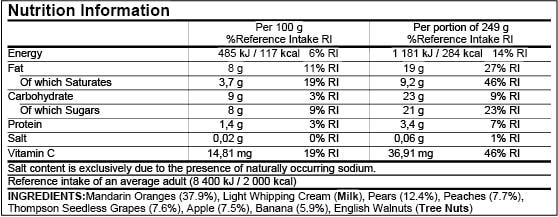

Nutrient Reference Values (NRVs) represent the levels of nutrients in various food products and are vital for food labeling in the European Union (EU). Individuals, depending on their age and other factors, need to consume certain levels of nutrients to function well and remain healthy. This is why the European Food Safety Authority (EFSA) and the World Health Organization (WHO) are implementing stricter regulations when it comes to NRVs and “Dietary Reference Values” (DRVs). These values further aim to inform consumers about the nutritional content of foods and help them decide which foods are healthy or unhealthy for consumption.
Table of Contents
In the early and mid-20th century, Recommended Daily Amounts (RDAs) were initially established and they guided the minimum amounts of vitamins and minerals needed to prevent nutrient deficiencies in the population. RDAs were used across many countries to steer public health policies, offer more balanced dietary recommendations, and standardize food labeling practices.
Over time, nutritional science shifted from preventing deficiencies to promoting optimal health and preventing chronic diseases. It also took into account that individuals require different levels of nutrients depending on their age, activity level, health status, and other factors, and this is why NRVs became more of a general reference than an exact recommendation like RDAs. This broader approach required a more comprehensive set of guidelines, which is when EFSA adopted Regulation (EU) 1169/2011 and Nutrient Reference Values (NRVs) came into the fold. NRVs include different categories of values, including:
This is how NRVs, in the form of The Reference Intake Range (RI) percentage, would look on a standard EU nutrition label:

These regulations have had significant implications for the way nutritional information is presented to consumers on food labels. Its aim is to make food labels clearer and more consistent across all EU member states so that consumers can make healthier food choices for their daily diet.
NRVs are calculated based on the EFSA dietary reference values that have already been set and established by the organization and are designed to cover different population groups, taking into account various age groups, genders, and life stages. In EU labeling, the use of NRVs helps consumers understand how much of a nutrient a serving of food or drink provides in the context of their total daily diet. The method involves calculating the percentage of the nutrient reference value that the food contributes, which is then displayed on the label.
NRVs are typically used on food labels to show the percentage of each nutrient that a serving of the food contributes towards the daily recommended intake. Supplements, on the other hand, are products that are intended to complement the nutrients you already get in your diet. They can contain nutrients like vitamins, minerals, enzymes, amino acids, and other substances. Supplements are usually sold in forms such as pills, capsules, powders, or liquids and their purpose is to provide nutrients that might not be consumed in sufficient quantities from the diet alone.
If you want to label your nutrition values according to NRVs, here are some practical steps to follow:
Companies like Food Label Maker create customized nutrition labels for you, ensuring that your recipes and labels follow updated compliance standards and are customized to suit your business needs. Their automated and easy-to-use platform allows you to input your nutrient values and displays them accurately and clearly for your product line.
Accurate and effective NRV labeling has had a large impact on public health and the EU food industry. The stricter regulations implemented by EFSA have steered manufacturers to include optimal levels of vitamins and minerals in their products and on product labels. This in turn encourages consumers to have more nutrient-rich diets with the minimum required amounts being in the food they eat.
Its relationship with nutrition claims and health claims also impacts more health-conscious consumers. As a reminder of these terms, a nutrition claim suggests that a food product includes beneficial nutrients to improve one’s health. Whereas a health claim implies that a certain nutrient or the nutrients within a food product can have a positive or negative impact on one’s function or health. NRVs are slightly different from these claims, as it is simply recommended values that should be followed for optimal health and are not necessarily used in a promotional sense like claims are.
The food product must also have a large or “significant” amount of that nutrient (vitamin or mineral) for it to qualify for any claim. However, NRVs, health claims, and nutrient claims are all ways in which the European Food Safety Authority (EFSA) uses transparent and comprehensive food labeling to encourage better food choices for people in the EU.
Understanding and utilizing Nutrient Reference Values (NRVs) is crucial for both consumers and businesses within the EU. NRVs provide essential guidance on the amount of nutrients needed for a balanced diet and optimal health. For consumers, knowledge of NRVs enables more informed dietary choices, helping them understand how much of a nutrient they consume relative to recommended levels. For businesses, ensuring that food products comply with EU standards on NRVs not only follows compliance standards but also enhances consumer trust and product credibility. Adhering to these guidelines is beneficial for business integrity and can contribute to consumer well-being.
The EU NRV (Nutrient Reference Value) refers to the set amount of a nutrient that is considered sufficient to meet the daily requirements of most healthy individuals in the European population. It is used on food labels to help consumers understand the nutrient content of food products in relation to their daily dietary needs.
The reference intake in the EU indicates the amount of energy (calories) and nutrients recommended for consumption each day. It is used on food labeling to provide consumers with information on how much of a nutrient or calorie a serving of food contributes to their daily recommended intake.
To calculate the reference intake for a nutrient, divide the amount of the nutrient in a serving of the product by the daily recommended amount (as per NRVs), and then multiply by 100 to get a percentage. This shows what percentage of the daily recommended intake of the nutrient is provided by a serving of the product. This helps consumers see how a food fits into their daily nutritional needs.

Maria Abi Hanna is an accomplished entrepreneur and dietitian, boasting a diverse career across nutrition and wellness domains.
As Co-Founder and CEO of Food Label Maker, she spearheaded the adoption of seamless technology to develop a world-class tool helping the food industry create compliant nutrition facts labels and providing a comprehensive recipe management solution.
Maria launched her career as a Clinical Dietitian at a leading meal plan and catering center where she provided client counseling, led corporate wellness initiatives, and played a pivotal role in foodservice and menu development. She then moved into the startup world co-founding a B2B nutrition consultancy where she worked with the food industry on menu concept creation, corporate wellness programs, and as a strategic consultant to different food tech startups in the region. Maria's other roles included co-founder and strategy lead for the region's first health and wellness platform and food delivery app; as well as founder of Nutrition Untold which highlights her commitment to digital nutrition counseling, focusing on non-diet approaches and aiding those with eating disorders.